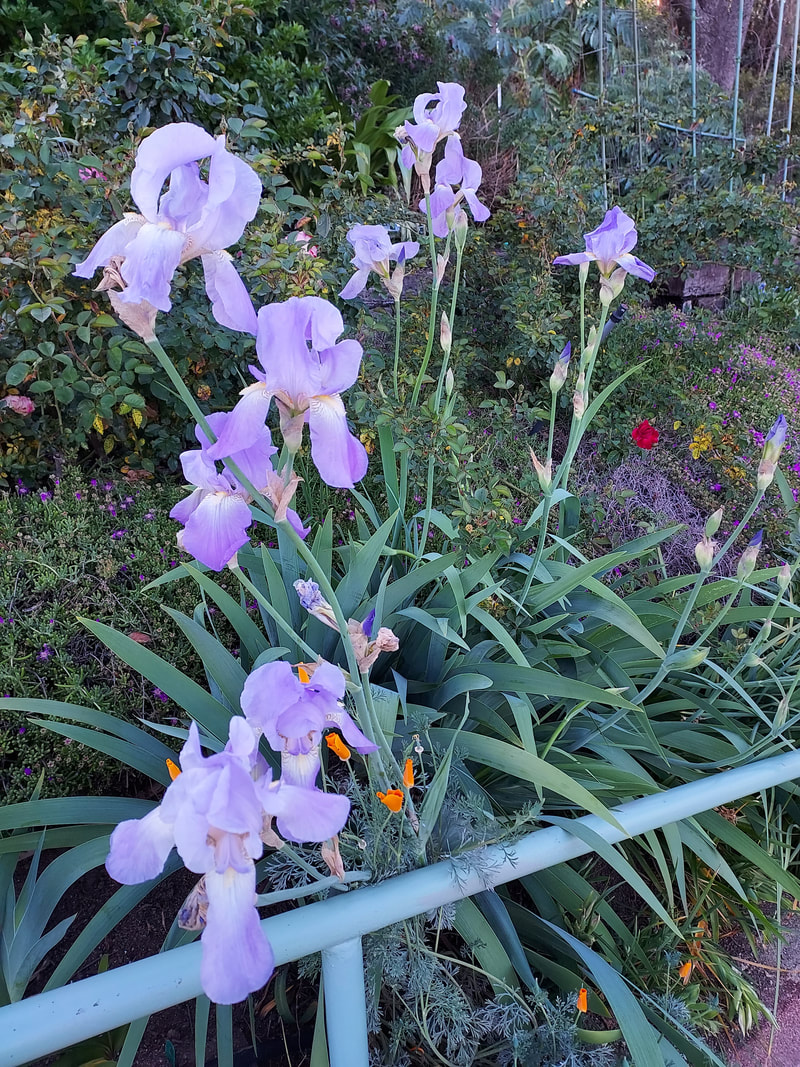After the mildest winter I can remember, and with considerably less rain than we’d like or are used to, we and our gardens are enjoying the lengthening amount of mild spring weather and looking very lush from that last big rain months ago. Of course, the weeds are thriving as well, but mostly only in the pathways.
Mulching My Pathways
Last fall, I had had the advantage of helpful neighbors transferring their trees’ leaves to my pathways, so weeds came up earlier this spring only in the places where no leaves had settled. Now that I’d pulled up those few weeds, I also pulled some too-vigorous one-foot-tall nasturtiums also in the pathways and placed them into the remaining open spaces in the pathways. This mulching of my pathways will deter further germination of more weeds in coming seasons.
Sowing Old Seeds
I decided to grow cucumbers again this year, which I hadn’t done for several years because I had another source. Consequently, my seed packets of some 10 varieties were 5 and more years old. Because it was mid-March, I figured I’d get some minimal germination so it’d be worth the effort if I sowed seeds very thickly – about 12 seeds in each cage. Now, a month later, I observed only 2 shoots, so tossed the remaining packets, purchased new seed and sowed about 6 seeds per cage. With this 80-degree warmth, I expect more success!
Same situation with my crookneck squash – tried the old seed but switched to new seed with several resulting plants. I’ll sow more seeds in a month to have continuous harvests of a few squashes every week. Don’t be disappointed if your first squash blooms shrivel and drop off – they’re probably the male flowers, which appear first. The female flowers will appear a bit later and get pollinated then, forming their delicious fruits. Be sure to pick them when they’re immature for best flavor.
Sowing Lettuce and Carrots
With temperatures in the mid-70s to 80s, I’ve sowed what may be my last lettuce seeds and carrot seeds for this spring. Unless the weather heats up suddenly, I should get a couple of months of salads and carrots before the plants bolt – go to seed.
Tomatoes Are Thriving
Tomatoes are happily putting out foliage and blossoms. But I’m removing every blossom until the plants reach the second rung of their cages, about 2 feet. This is to force the plants to continue establishing their strong root systems instead of diverting their energy into making fruits.
I’m also making sure to water plants only once a week, both filling the planting holes and the buckets between each plant. This forces the developing roots to reach down into the soil to follow the cool water, resulting in a deep root system that’ll support the plant when the hot weather comes. If you water more frequently and shallowly now, the root systems will remain in the upper area of the soil which will get hot when the hot weather comes, and you’ll have to water every other day or so just to keep them alive.
Mulching My Pathways
Last fall, I had had the advantage of helpful neighbors transferring their trees’ leaves to my pathways, so weeds came up earlier this spring only in the places where no leaves had settled. Now that I’d pulled up those few weeds, I also pulled some too-vigorous one-foot-tall nasturtiums also in the pathways and placed them into the remaining open spaces in the pathways. This mulching of my pathways will deter further germination of more weeds in coming seasons.
Sowing Old Seeds
I decided to grow cucumbers again this year, which I hadn’t done for several years because I had another source. Consequently, my seed packets of some 10 varieties were 5 and more years old. Because it was mid-March, I figured I’d get some minimal germination so it’d be worth the effort if I sowed seeds very thickly – about 12 seeds in each cage. Now, a month later, I observed only 2 shoots, so tossed the remaining packets, purchased new seed and sowed about 6 seeds per cage. With this 80-degree warmth, I expect more success!
Same situation with my crookneck squash – tried the old seed but switched to new seed with several resulting plants. I’ll sow more seeds in a month to have continuous harvests of a few squashes every week. Don’t be disappointed if your first squash blooms shrivel and drop off – they’re probably the male flowers, which appear first. The female flowers will appear a bit later and get pollinated then, forming their delicious fruits. Be sure to pick them when they’re immature for best flavor.
Sowing Lettuce and Carrots
With temperatures in the mid-70s to 80s, I’ve sowed what may be my last lettuce seeds and carrot seeds for this spring. Unless the weather heats up suddenly, I should get a couple of months of salads and carrots before the plants bolt – go to seed.
Tomatoes Are Thriving
Tomatoes are happily putting out foliage and blossoms. But I’m removing every blossom until the plants reach the second rung of their cages, about 2 feet. This is to force the plants to continue establishing their strong root systems instead of diverting their energy into making fruits.
I’m also making sure to water plants only once a week, both filling the planting holes and the buckets between each plant. This forces the developing roots to reach down into the soil to follow the cool water, resulting in a deep root system that’ll support the plant when the hot weather comes. If you water more frequently and shallowly now, the root systems will remain in the upper area of the soil which will get hot when the hot weather comes, and you’ll have to water every other day or so just to keep them alive.

No Responses